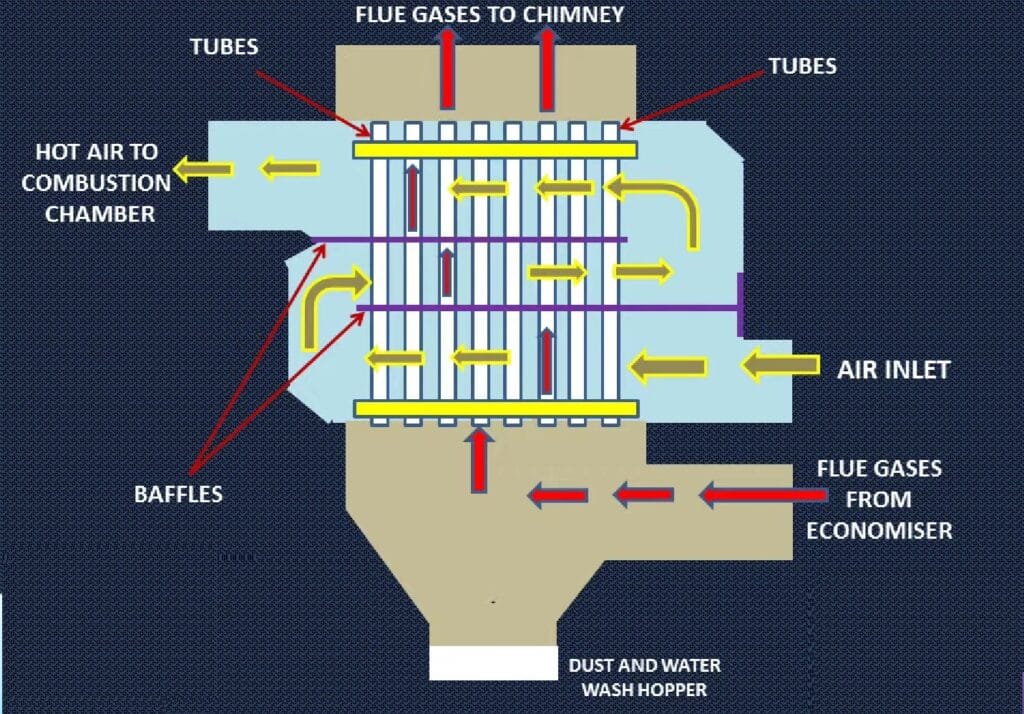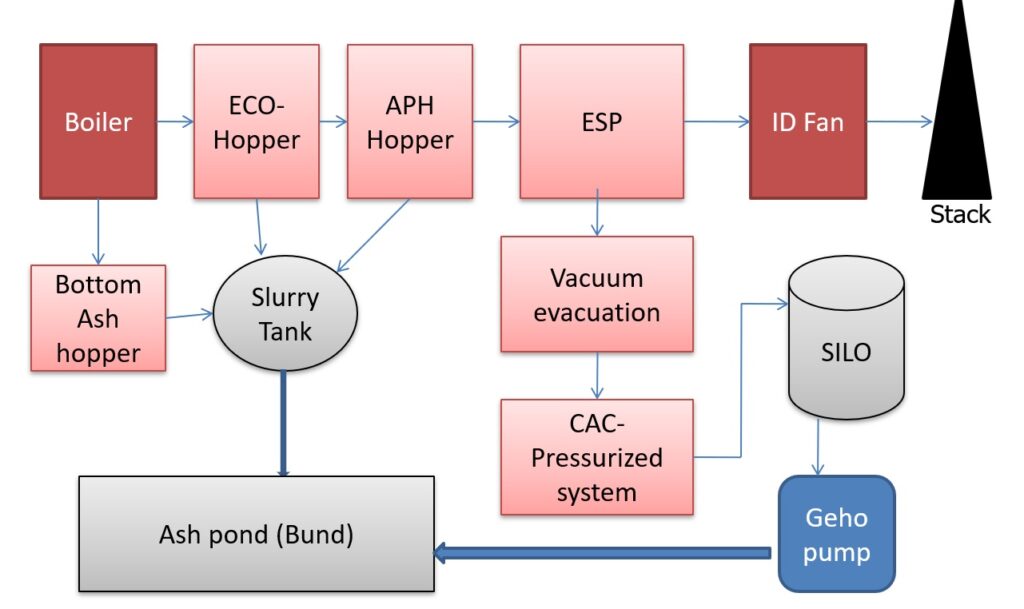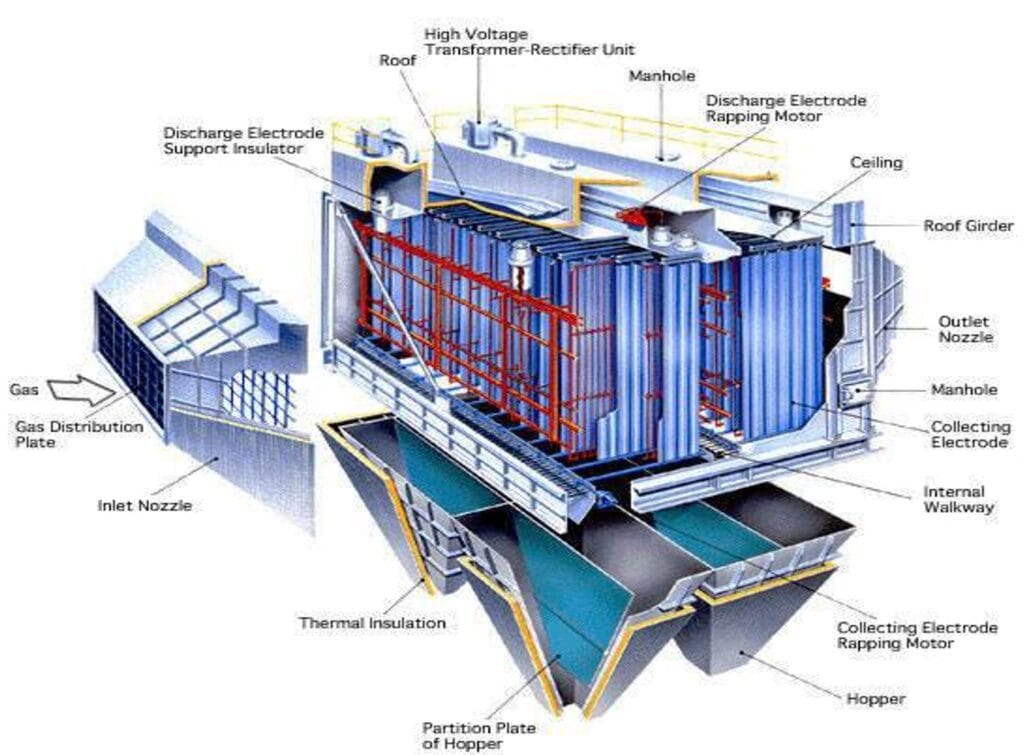Table of Contents
ToggleAir preheaters (APHs) are essential components in boiler systems, playing a unique role among boiler auxiliaries. Their primary purpose is to recover heat from the flue gas and utilize it to preheat combustion air, thereby significantly improving overall energy efficiency. This process can boost boiler efficiency by 8-12% and positively impact plant capacity and heat rate, making APHs an income-generating asset for utility owners.
For every 22°C increase in the temperature of combustion air, the overall boiler efficiency improves by approximately 1% in fired boilers. However, modern air preheaters often operate under conditions far removed from their original design specifications. Factors like changes in fuel, load, and environmental requirements impose additional challenges, requiring innovation and effective maintenance practices to ensure optimal performance.
Types of Air Preheaters
Air preheaters are categorized into two main types:
- Recuperative Air Preheaters
These include tubular, plate, and heat pipe designs. Recuperative air preheaters transfer heat through a solid medium, offering durability and simplicity. - Regenerative Air Preheaters
Typically of the rotating matrix design (e.g., Ljungström type), these preheaters store and transfer heat using a rotating structure filled with heat-transfer elements. Their high efficiency, compact design, and adaptability make them a preferred choice for large boiler applications.


Key Challenges in Air Preheater Operations
Air preheaters face several operational challenges, including:
- Cold-End Erosion and Corrosion
The cold-end region of the air preheater is prone to corrosion due to moisture and acid condensation. Using corrosion-resistant materials, such as imported “A” grade alloys, can help mitigate these issues. - Fouling and Plugging
Fouling from deposits, such as ammonium bisulfate (ABS), can restrict airflow and reduce efficiency. Regular cleaning and maintenance are critical to prevent such build-up. - Seal Leakages
Seal leakages can lead to reduced efficiency and increased emissions. Innovations like automatic clearance-sensing devices for seal adjustment help minimize these issues. - Rotor Wear
In rotary regenerative air preheaters, rotor components, including baskets and elements, can erode over time. Reversing or replacing eroded baskets when wear exceeds acceptable limits (e.g., 50mm height erosion or one-third of thickness) is necessary to maintain efficiency.
Maintenance Practices
Routine Maintenance for Recuperative Air Preheaters
Maintaining recuperative APHs involves:
- Monitoring Performance: Ensure cleaning equipment, steam preheat coils, and cold-end temperature controls are in good working condition.
- Cleaning Tubes: Persistent fouling may require mechanical or high-pressure water cleaning.
- Cold-End Tube Repairs: Installing sleeves inside damaged tubes can delay replacement, although it may increase draft losses and require operational adjustments.
Maintenance for Rotary Regenerative Air Preheaters
Rotary regenerative APHs require detailed inspections and upkeep:
- Inspect Rotors: Check for erosion and corrosion, particularly in systems with high air-to-gas pressure differentials or frequent cycling.
- Examine Welds: Inspect critical weld areas, including diaphragms, shell welds, and bypass seals, for cracks or damage.
- Seal Inspections: Ensure seals are properly set and in good condition to prevent air-to-gas leakage.
- Element Checks: Evaluate heat transfer elements for wear, corrosion, and plugging.
- Bearing Maintenance: Analyze oil samples from bearings and gearboxes for metal particles, and ensure drives are in good condition.
Advancements in APH Design
Recent innovations have significantly enhanced the performance and reliability of air preheaters:
- Improved Heat Transfer Surfaces
Modern designs feature advanced heat transfer surfaces that are easier to clean and more resistant to fouling. - Leakage Reduction
Enhanced sealing systems and slower rotor speeds (from 4-6 RPM to 1-1.5 RPM) have reduced air-to-gas leakage. - Adaptability
Regenerative designs allow for easy upgrades or modifications to accommodate changes in fuel type or environmental control equipment. - Automated Seal Adjustment
Future designs will incorporate automatic seal adjustments using clearance-sensing technology to optimize performance further.
Heat Transfer Surface Design
Heat transfer surfaces, also known as heating elements, are critical for optimizing heat exchange between flue gas and combustion air. These elements are arranged in layers:
- Cold-End Elements: Made from thicker alloys to resist corrosion, fouling, and plugging.
- Hot-End Elements: Thinner alloys that handle higher temperatures with reduced corrosion risk.
Selecting the appropriate heating element materials and configurations is crucial for balancing thermal performance, fouling resistance, and durability.
Performance Optimization
The primary function of air preheaters is to absorb heat from flue gases and release it to combustion air. However, their performance depends on:
- Minimizing Fouling and Corrosion: Particularly at the cold end, where temperature gradients are most pronounced.
- Ensuring Effective Cleaning: Employ advanced cleaning technologies like Jetblowers for both on-line and off-line cleaning.
Leakage Control in Air Preheaters
Air-to-gas leakage occurs in regenerative air preheaters and is categorized as:
- Direct Leakage: Driven by air-to-gas pressure differentials, this is minimized by seal adjustments.
- Entire Leakage: Caused by rotor volume transfer between air and gas sides, proportional to rotor speed and volume.
Seal designs, including radial, axial, and bypass seals, are critical for limiting leakage and maintaining efficiency.

Thermal Effects on Rotor Structure
The continuous heat exchange creates a temperature gradient across the rotor, causing predictable thermal deformation known as “rotor turndown.” This phenomenon affects seal settings, requiring precise adjustments during both cold and operational states.
Future Trends
The air preheater industry is evolving to meet modern operational demands. Future trends include:
- Increasing the number of A.H. sectors for better efficiency.
- Incorporating automated seal setting devices.
- Reducing rotor speeds for minimized leakage and wear.
Conclusion
Air preheaters are income-generating assets that significantly enhance boiler efficiency and capacity. While the majority of utility boiler air preheaters operate beyond their original design specifications, regular maintenance and innovative upgrades ensure their continued reliability.
Through advancements in design and meticulous upkeep, air preheaters can adapt to modern operational challenges, reduce emissions, lower maintenance costs, and improve fuel efficiency. By leveraging these opportunities, utility owners can maximize the value and lifespan of their air preheater systems, ensuring they remain integral to sustainable energy production.
Recent posts
Related posts:
- Rankine Cycle in Thermal Power Plants
- Modes of Coal Transportation in Power Plant
- Coal Handling Plant – CHP
- Protections in Coal Handling Plants and Challenges
- Fuel Firing in Boiler
- Boiler Construction: History, Types, and Key Components
- Bowl Mill (Pulverizer) in Thermal Power Plant
- Coal Feeders in Power Plants


